#getting the wing membrane on and folded in that awkward position and then the limbs fluffed after when there's no room anywhere
Note
whats your favourite sculpture youve made
That's a hard one. Lunaspis maybe? But I'm not sure if I like this one so much necessarily because I made it or just because "Fishy :)", ya know?
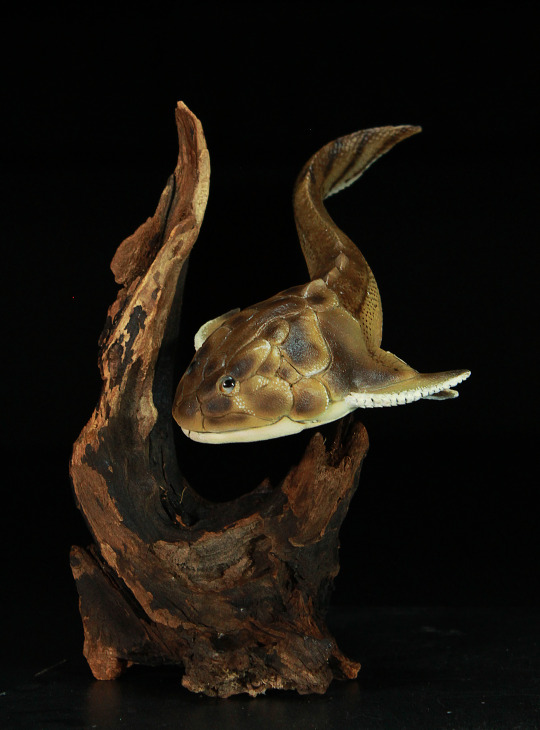
Scratchy is my masterpiece though, as far as technical achievements go.
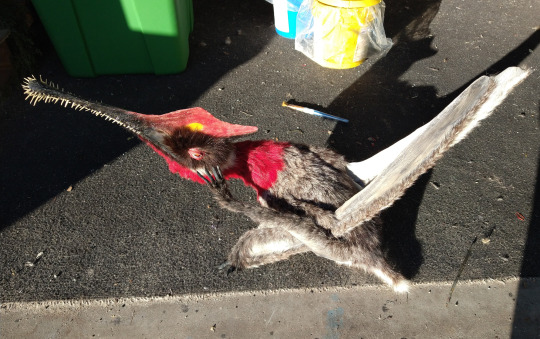
#Transluscent interlocking teeth and crest#nictitating membrane and very tiny eyelashes#getting the wing membrane on and folded in that awkward position and then the limbs fluffed after when there's no room anywhere#Also I made and set a whole different set of teeth first and didn't like them so I ripped them out to start over#all worth it for a little creechur#Honorary mention to the Sinosauropteryx leaping for a bird which probably has the best composition of anything I've made#and that little etsy raptor that was laying down I didn't expect it to come out so cute
175 notes
·
View notes
Photo
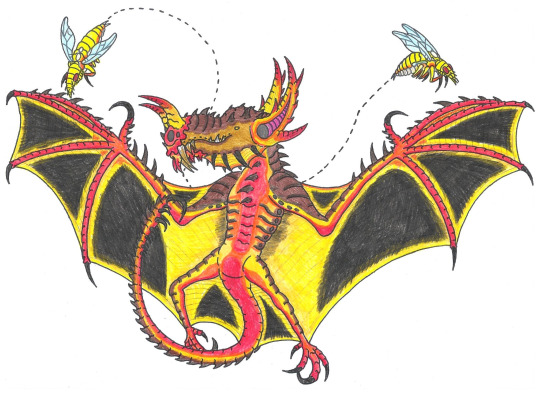
Out in the endless savannas and deep in the hearts of ancient jungles, the Pterorcus rules as king. A master of the night sky, it is a predator that knows no equal in its territory. Now of course, some may wonder what a Pterorcus is, as I have heard the question many of times. "If it is such a great and famous predator, then why haven't I heard of a Pterorcus before?" they say dumbly. Then I say that it is a huge bat creature and they immediately reply, "oh yeah, you mean a Bat Dragon!" At that point I plant my face into the table and scream in frustration (not really, but you know what I mean). Yes, the Pterorcus is also known as a Bat Dragon. I have no idea why it is so hard to just call it what it is, but no, we got to make some hyperbolic title for this fascinating creature and demonize it! Ugh! Regardless, the Pterorcus is winged mammal that is found upon the arid continent. They are found wherever caves and caverns may form, as those formations serve as their lair. Though massive in size, these beasts are rare sights. During the day, they remain in their hidden lairs, sleeping most of the time and partaking in the occasional grooming. They will only leave this shelter at night, and many folk don't have eyes that can see too well in the dark. Plus the Pterorcus fly high up in the sky, making them difficult to spot despite their bright coloration. Their flying ability is quite impressive, as they have incredible maneuverability despite their large size. Their wings and membranes are very flexible, and they use this to pull off precise dives and turns when they are hunting. While flight is their major form of movement, they are also capable of traveling on land. This is done by folding their wings and walking on all fours. Well, it is more like awkward hopping and crawling, as their limbs aren't best suited for such a thing.
Due to its size and unfortunate "dragon" name, you may guess that this species is a powerful carnivore. That is correct, as no tiny bugs and bits of fruit will satisfy a beast of this proportions! Like other bats, the Pterorcus hunts exclusively at night. Hunting and finding mates is the only reason they leave their lairs, and these times are when every creature of the land lives in fear. If their cave is in an open and exposed area, then they may fly straight out. A good chunk of their homes, though, are often hidden in choking jungles and cluttered forests. In these cases, they will use their large hooked claws to climb to the canopy, where their huge wings may unfurl freely. With a mighty flap of these powerful limbs, they take to the sky and begin their hunt.
To locate prey, they do not rely on sight, as their eyes are very small and weak. Instead, they use smell and sound to find suitable targets. Their massive, elaborate noses are incredible at picking up the slightest trace of food, while their huge ears can soak up the faintest of whispers. Gliding through the night sky, they follow these invisible trails, all while using their own echolocation to map out the environment. Prey that is out in the open is doomed when these great beasts take flight, as they cannot escape its extraordinary senses and piercing claws. These huge predators will swoop down and use its prehensile tail to snare their target. Since their wings are vital tools to their survival, they prefer to use their tail to wound and immobilize prey. The nasty hooks and barbs on this appendage easily sink into flesh, and when this happens, the victim is up for a terrifying ride. If they are light enough, the beast may fly back up to higher altitudes, hauling its prey with them. Their meal shall be taken to a nice safe place where they may eat in peace. If they hook a larger creature, they will not be able to lift it. Instead, they will keep flying low and just drag their victim behind them, like a prisoner being drawn to an execution. Most prey of this size are ungulates, which do not do well when violently toppled over. After a few moments of towing their prey through the brush and dirt, the Pterorcus will land and finish the job. Huge fangs quickly dispatch any trapped prey, and the Pterorcus may eat its fill. Now some may notice that the Pterorcus relies on its wings and flight to hunt down and kill its food, so they may wonder about safety in cover. Surely hiding in the forest or jungle will protect you, as how could such a beast fly in there? This is a fair point, and one that many creatures agree with! When night falls, some animals and groups may retreat to these cluttered havens. In Pterorcus territory, even entire herds may seek shelter when the dark arrives. So with them tucked away in these tight quarters, how does this winged predator get its prey? Well, the space may be too cramped for a Pterorcus, but not for some small fliers. It turns out, these great beasts don't hunt alone...
When a Pterorcus leaves its cave at dusk, it often is carrying some passengers with it. Clinging to its back are an insect species known as Pearl Flies, who have an incredible symbiotic relationship with the Pterorcus. I will go into more detail about them in their own entry, but in this case, the male Pearl Flies will hitch a hide with the giant bat. When the Pterorcus gets in the air above its hunting grounds, the flies will drop off and spring into action. Focusing on dense areas where the huge creature cannot properly fly, the Pearl Flies will dive in and search for resting prey. With incredible agility and speed, these little guys can weave through jungles without slowing a bit. Using all their senses, they look for large animals that may serve as suitable prey. Groups of sleeping herbivores and grazers are perfect targets, and the team of Pearl Flies will zero in on them in a flash. With their small size, some may think they would be useless against such large creatures, but the Pearl Flies do not intend to attack them. Instead, they use special tymbals that can create a wide arrange of sounds to dupe their targets. With their speed and raucous noise, the Pearl Flies will harass the resting creatures and make it seem like they are being attacked. Just imagine if you were sleeping out in the woods and a bunch of flying critters started tearing through camp screaming and raising all sorts of din? You would be in quite the panic too! With this loud and continuous assault, many creatures are whipped into a panic and begin to flee. Once prey is on the move, the hunt is on.
The Pearl Flies will follow in pursuit, using their mimicry and vocalizations to further terrify their prey. Their agile flying is also used to herd their targets in a specific direction, forcing their stampede into the open savanna. The noise of panicking animals is obvious to the waiting Pterorcus, and it will hang above the area where the fleeing creatures will emerge. Bursting from the forest in a blind frenzy, the prey is further targeted by the pursuing Pearl Flies. When they are out in the open, the flies will try to isolate a target, using their noise and movements to drive it away from the group. The Pterorcus will attempt to do this as well, using its deafening shrieks to startle prey and disorient them. In some cases, the Pterorcus may release such a powerful scream that it can actually hurt prey and knock them off their feet. A sudden explosion of pain can cause an animal to stumble and fall, where they are either trampled to death by their fellow herd mates or picked off by the great bat. This method doesn't ensure a downed animal each time, so it is more used to try and break up a running herd. When an individual is alone and out in the open, the Pearl Flies will let out sharp buzzing call. At first it was believed that this sound only alerted the Pterorcus to potential prey, but further studies have shown something fascinating. This special sound is instead directed at the running prey, as the Pearl Flies are bombarding it with noise. What the Pearl Flies are doing is marking the victim, painting them with sound that the Pterorcus can easily locate. It is the equivalent of strapping a torch to the panicking beast, acting as a beacon that says "here's dinner!" With this group effort, the Pterorcus can easily take down the victim. With the help of Pearl Flies, these hunts have an incredible success rate, which is why such a relationship exists. These insects drive food right into the waiting claws of their huge friend, and the spoils are shared amongst the group! The Pearl Flies get to join the feast when the victim is dispatched, and their portions will go back to their mates and young that wait in the Pterorcus' lair.
When it comes to mating season, the female Pterorcus take to the air and let out a specialized call. From within their lairs, the males will respond back with booming cries of their own. To ensure that their song is heard loud and clear by the aerial female, the males will often clean out the mouth of the cave and position themselves so that it amplifies their call. Up above, the female judges the songs she hears, listening for one that indicates a strong male. This decision is not made in an instant, instead she will fly far and wide throughout the night, hearing any suitors that she can find. Her journey will cover a huge area, dozens of leagues in a single night as she seeks the perfect mate. During this time, the males will continue to listen for her and call out whenever they hear her voice. As dawn arrives, she will fly back to where she heard the favorable song, remembering the exact location of this chosen male. She will call to him and will follow his voice to his lair. There, the two shall become mates and the process of starting a family will begin. In time, the female will give birth to two pups, which she will nurse and protect. When the young are just born, the male Pterorcus will do all the hunting, bringing food back to the mother. As they grow older, the parents will switch roles each time, that way the male and female can keep their hunting senses sharp. Eventually the young will get old enough to join in the hunt, and each parent will take one along with them. This is when they learn to take down prey and fend for themselves. In time, they will leave their parents and go off on their own. As for the parents, these two may stick together or may break apart. It seems that the female judges the male as they raise their offspring, and if she finds him unsuitable for the task, she may seek out another partner in the end. It is believed this encourages males to do their best when dealing with their young, as it will secure them a mate for life, which then leads to a higher success rate for their pups. It seems like no matter what branch of life you are from, the struggle of love and relationships is the same!
With them being a huge predator and a species marked as a "dragon," you can probably guess their relationship with the people around them. Pterorcus are surrounded by fear and superstition, with many cultures viewing them as symbols of death and disaster. Their terrifying calls and explosive screams are seen as omens whenever they are heard, with many saying that they are a sign of bad luck. Their carnivorous appetite has also led to these creatures targeting livestock and cattle, dragging a farmer's livelihood off into the night. Despite the stories, Pterorcus do not hunt down and eat people, as they are too small and scrawny. However, if you are screaming and hurling stuff at one of these beasts, then they may choose to eliminate a nuisance. Many casualties occur when people attack a feeding Pterorcus, as it is usually feasting on someone's cow. Others happen when people seek out the bat's lair and try to kill it there, causing it to fight back in self-defense. While these stories of bloodthirsty Bat Dragons are terrifying, they tend to ignore the fact that many of these creatures have been killed. Pterorcus used to inhabit a wide range, making their homes in canyons, mountains, forests and jungles. However, fear has driven people to hunt them down and kill them, viciously cutting down their numbers. Now these creatures can only make their lairs where it is hard for people to access them. High up on mountains or deep in jungles are the only safe places for them, and that is where they are mainly found today. Thankfully, the population seems to have stabilized after this terrible event, though it is probably impossible for them to return to the strength they had so long ago.
Though many are quick to fear these beasts, the Pterorcus have certainly made an undeniable impact. Symbols and depictions of them can be found in a wide variety of artwork, and certain ceremonies call for folk dressed as one of these great bats. There are numerous stories in folklore that speak of these creature's origin as well as their actions. Some tales say that the Pterorcus will catch souls as they drift away, and the piercing cries of one of these bats is a sign that they devoured a victim. Others say that these bats tried to cheat humanity as they claimed fire, attempting to steal away the flames for themselves. When the beasts engulfed the sun's stolen flame in their wings, the heat burnt their skin and blinded their eyes. The god of sun blamed the theft on the burning Pterorcus, and vowed revenge if they dare saw them again. Thus the bats are banished to the night, while humanity smuggled away the flame unnoticed. Outside of folklore, the Pterorcus have recently gained interest when people learned that their dung makes excellent fertilizer. This guano is highly prized and folk looking for some quick money now hunt for these lairs. Such searching is done at night, when the beast is away from home. It is risky business though, as the cave may not be empty when they enter it. Female Pearl Flies remain at home to guard their young and eggs, and they are quite defensive. Also, if it is a home to a mated pair of Pterorcus, one of the parents will still be there. If that happens, these guano hunters may wind up as very the dung they were searching for!
Chlora Myron
Dryad Natural Historian
--------------------------------------------------------
A long, long time ago in an entry far, far forgotten, I made mention of various types of dragons that existed in this world. There was a passing mention of things and one of them was Bat Dragons. Of course such things were just fluff, right? Well not anymore! Even if it is years later, we are making a Bat Dragon! Of course this was originally going to be your earthy browns and greens in color, but then I found that colorful bats exist and used that as an excuse to change things up. Why would a giant night predator be so colorful? No clue, but honestly doing plain and simple coloration is a bit boring some times.
32 notes
·
View notes
Photo
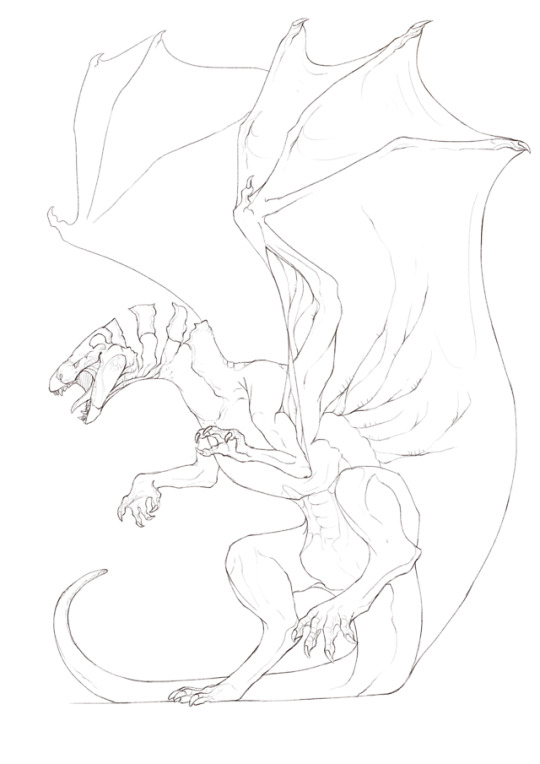
h e wwo i’ve been meaning to do this for a while but !! never had a proper art piece to submit for critique and finally i’ve made a fullbody dragon hell yeah
the legs are kinda wonky and i’m fIGURING EM OUT but yeah this is a take on Flamecaller from Flight Rising
(please ignore the weird cuts in the neck there’s supposed to be fire there)

hewwo!!
before I start, I gotta say I fuckin LOVE your style here! the detail in the skin textures is exquisite, and I love the way u shaped Flamecaller’s head/neck!

so the main problem w/ the front legs is their connections to the chest. idk if this is a conscious art direction on FR b/c SO MUCH of the art features this mistake, despite varied artists, but FR has a real problem w/ not properly attaching limbs– particularly front legs– to the body. Flamecaller herself is a particularly egregious example of this, as I’ve mentioned in the past, so I can’t rly blame u for following the script w/ her design here
first I shifted the shoulderblades so the bottom points (where the humerus meets the scapula) are closer to the front end of the ribcage where the pecs ought to be. this allowed me to draw more substantial connections between the shoulders and pecs. note how I did this– instead of making a solid line from the arm all the way over the curve of the shoulder, I instead ended the front arm line right at the edge of the shoulder connection, then drew in a small UNCONNECTED curve to indicate the mass of the shoulder under the flesh. extending the arm lines up completely unbroken as far as u did implies 0% connection b/t the arm and the body, so it helps to use less connected curves/lines once the arms reach the body mass, to imply internal connections underneath the flesh instead. I also redistributed the mass of the upper arms a bit, and moved the far arm down/in a bit closer to the chest
also note how the throat doesn’t flow quite as smoothly into the chest anymore, but rather ends distinctly at the indication of collarbones. even in splayed-leg structures where the torsos can merge more smoothly w/ the neck, connections are rarely SO smooth, so this goes double for a non-splayed structure w/ a flexible neck, such as with Flamecaller
as for the wings, I first had to restructure the chest for proper musculature. w/ just abt any ribcage, the front end is gonna be more narrow than the back. this is esp tru for a structure like this, where the front limbs will have dramatically less shoulder muscle mass than the powerful wings just behind. thus, I pushed more of the chest mass from the front to the back. I also just made the chest thicker/longer in general for more support/structure, + I think it matches Flamecaller’s tapering torso better
now, in terms of aesthetics, idk how big u want Flamecaller’s wings to be here. for realism, you’ll want the arm/finger lengths to match or extend a bit past mine, but I can see how u’d prefer ur original wing sizes for the look of this individual piece as a whole. whatever u decide, the proportions WITHIN the wing need some work. the general rule for wing proportions is that the upper arm is thick/short for thrusting power, while the lower arm is long/thin for surface area and supporting membrane. for the fingers, the base sections connecting to the wrist should be the longest/thickest for stability/support, then should get thinner/shorter as u move to the tips, which should be the thinnest/shortest for delicate maneuverability of the edge of the membrane. the musculature of the wing also looks a bit wonky, so I’d suggest looking into bat wing musculature to help get a better feel for it
now kind of a nitpick w/ Flamecaller’s design: the way her front-edge wing membrane attaches down onto the back of her front limbs is SUPER impractical for flight. it would only serve as an obnoxious barrier against oncoming air currents, and rly doesn’t seem to serve any other purpose. whether u keep this for aesthetics or not is whatever, b/c in the grand scheme of anatomical mistakes it’s one of the lesser ones, but I just wanted to let u know
the hind legs suffer from proportion problems as well, mainly in the foot sections being FAR too long. thus, I cut down the foot lengths and lengthened the lower legs a bit as well (while this isn’t always the case, it’s often the lower legs that are longer in quads and even many bipeds like birds). I also shifted the far leg closer to the torso b/c it looked to be floating a bit too far away from the hips. the position of the close leg was HIGHLY awkward, w/ the heel pushed back almost behind the hip, so I pulled the knee down/forward, and the heel naturally followed to a more comfortable position below the hip. this awkward leg positioning is also a HUGE problem w/ FR art, so I can’t rly blame u for following that script either
Flamecaller looks to have ornithischian hips to me, tho she could possibly have saurischian instead, I’m not sure. since I’m going w/ ornithischian, I pulled her pubic bump down a bit past her rump, as seen below (saurischian featured in the top pic, ornithischian featured in the bottom)
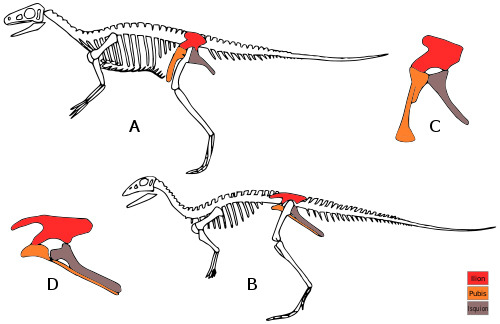
also I’m not sure if u made her hind dew claw/thumb into a regular toe on purpose or not, but I just added it back in for canon consistency. I’m also not sure that she actually has a thumb on her wings? it’s a lil’ hard to tell w/ the fold-over of membrane in her ref. it’s on u to keep these features or not, just thought I’d point ‘em out /shrug/
hope this helps!
-Mod Spiral
31 notes
·
View notes